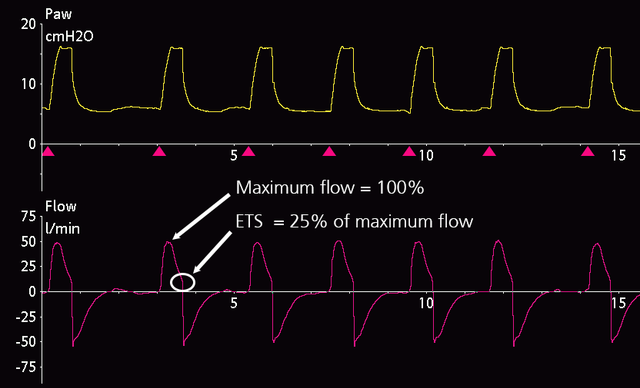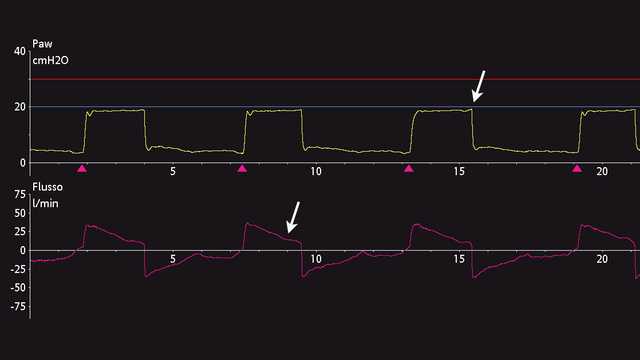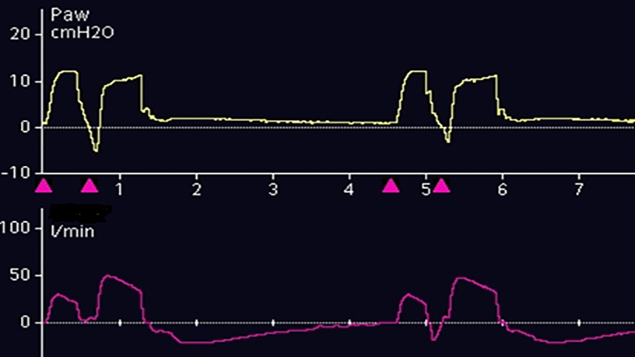
作者: 临床专家组,Hamilton Medical 哈美顿医疗公司
日期: 22.02.2018
最佳的人机同步至关重要,因为不同步会导致呼吸功增加和病人不适。

不同步也与更高的死亡率和长时间机械通气有关 (
当尝试将呼吸机与病人的活动同步时,有两个主要设置需要考虑:吸气触发和呼气触发。这决定了呼吸机何时开始或结束自主呼吸。在 Hamilton Medical 哈美顿医疗公司呼吸机上,呼气触发设置为呼气触发灵敏度 (ETS)。此值表示吸气峰流量的百分比,达到此百分比后呼吸机从吸气阶段切换到呼气阶段。在 Hamilton Medical 哈美顿医疗公司呼吸机上,ETS 可设置为 5% 和 80% 之间的任何值。通常,增加 ETS 设置导致吸气时间缩短,而降低 ETS 则导致吸气时间延长。
在其他设备上,此流量周期机制称为 ‘ESENS’、‘End Inspiration’、‘Flow Cycle’ 等。
呼吸终止的另一个标准是最大吸气时间。如果漏气严重且未达到设定周期,则使用该设置,提供后备通气,从而可以终止吸气。达到所设的最大吸气时间时,呼吸机会切换到呼气阶段。
接受无创通气的肺力学正常病人的典型 ETS 设置为 25%,这是 Hamilton Medical 哈美顿医疗公司呼吸机的默认 ETS 设置(见图 1)。对于呼吸道阻塞病人(如慢性阻塞性肺部疾病 (COPD)),应将 ETS 设置得更高,以增加呼气时间,从而避免空气陷闭和内源性 PEEP。
导致呼气不同步的错误 ETS 设置可从导致双重触发的延迟或过早切换中识别出来。

延迟切换可以从主动呼气努力引起的压力曲线中的吸气末峰值,以及吸气流量向基线的斜率变化中识别出来(见图 2)。通常在 COPD 病人中描述这种情况。吸气流量的减少较小,可能是由动态过度充气和气道阻力导致的。
在延迟切换的情况下,以 10% 的增量增加 ETS 以缩短吸气时间 (TI),并根据病人状况调整最大吸气时间。
除了吸气时间短外,双重触发也是过早切换的一个征象(见图 3)。在过早切换期间,吸气肌肉继续收缩,导致呼吸机预计会再次用力。这导致双重触发,伴随更高的潮气量输送、呼吸堆积和更高的呼吸功。一种可能的解决方案是尝试将自然吸气时间与呼吸机吸气时间相匹配。压力支持不足也可能导致双重触发。
在双重触发的情况下,以 10% 的增量减少 ETS 以延长 TI,根据病人状况调整最大吸气时间,或增加支持压力以达到所需的潮气量。


HAMILTON-C6 和 HAMILTON-G5/S1 呼吸机使用 IntelliSync+ 提供自动调整选项(

我们的异步参考卡向您概述了最常见的异步性类型、它们的原因以及如何检测它们。